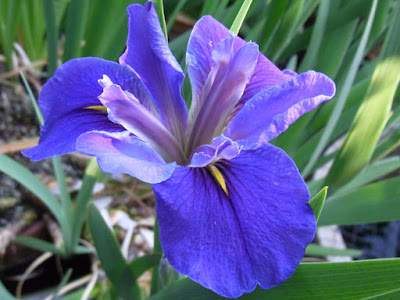Some mornings, I know exactly how daisies feel. It's not enough for the sun's early appearance to turn night into day. What daisies need is to feel the sun's warm, direct rays beating down on their flowers, and then (and only then) will they open up and do their thing.
Looking like a cluster of mini suns, the "surprise" part of this purple-leafed, yellow-flowered daisy bush is that it's a lettuce plant enjoying its floral fling before signing off on a life well lived, however briefly.
This handsome purple tower was once a low-growing, purple patch of "pick-and-come-again" loose-leaf lettuce, looking much like its green lettuce siblings growing at its feet. Then, two weeks ago, it made its break for adulthood and rose daily, inches at a time. I watered it and gave it a feed to encourage it, and in the last few days it has repaid the favour with its own flower show. Bravo!
In a recent posting on bees I showed you a photo of this shallot flower, but it's so delightful I want to show it again. And it's not alone in this world, either. While I have another mini patch of shallots growing well in another bed, I've very happily watched these shallots doing their flowery thing for the last few weeks. There used to be more of them in fact, but in the last few days both Pammy and I have harvested some from this patch for dinner, and they're still perfectly fine to cook with, but probably getting a bit too strong-flavoured for salads anymore.

My final little October surprise is this perfectly predictable scene of our common sage bush in bloom. The "surprise" factor is simply that it is flowering so well this year. It was looking utterly rough, scrawny and bedraggled in the middle of winter, so I adopted the simple policy of "cut off all the ugly bits" (and there were a lot of them, too). It seems to have worked. All the healthy wood that was left has burst out in new growth and, in the last few days, created this explosion of mauve good health.
Sage has wonderfully complex flowers, too. With their mouths agape as if singing a long, high note to finish a song, sage flowers remind me of some orchids.
I have no problems imagining that on other planets, alien life could easily be comprised of flowering plants that talk.



















